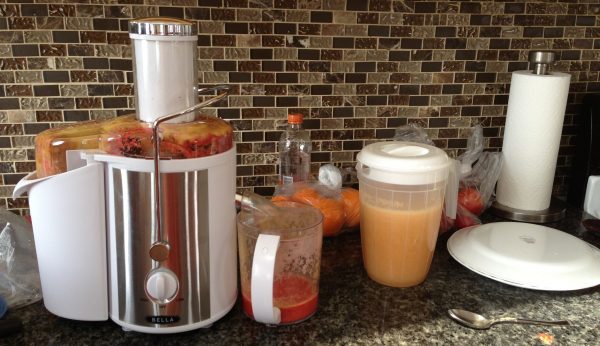A Healthy Diet Can Cut Down on Finals Stress
By selecting a consistent and healthy diet early on in the semester, students can better succeed during finals week. (JENNIFER KHEDAROO/OBSERVER ARCHIVES)
December 10, 2016
Maintaining a healthy diet is paramount during any point of the semester, but especially during stressful periods such as midterms and finals. However, students sometimes put off the importance of taking care of their health. If students develop the proper eating habits early on in the semester, it will be much easier to cruise through stressful periods both with a healthy mind and a healthy diet.
What constitutes a healthy diet? First and foremost, students should consume a variety of foods. By eating a wide assortment of foods, students can ensure that they are receiving the maximum caloric and nutritional benefits of what they are eating. At the same time, portion sizes are key. This is especially the case for high-calorie foods such as chicken, beef briskets, salmon, quinoa and brown rice. Since serving sizes have increased tremendously in recent years, especially at restaurants or with canned foods, reading the nutritional facts beforehand will help students not exceed their daily caloric intake. Fordham University Dietitian, Melanie Simeone, R.D., stated, “There are visual guides to help students implement correct portion sizes. [Every] individual has unique calorie and nutrition needs. But, using these guides can help [students] see where [they] may be over-portioning.” The United States Department of Agriculture (USDA) recommends that the average moderately active male and female between ages 18-25 take in 2,800 and 2,000 calories, respectively.
Another key component of a healthy diet is consuming plenty of produce. It is recommended to eat two-and-a-half cups of vegetables and two cups of fruit each day, for the 2000-calorie diet. Those who are in a weight-loss regimen should eat less than the aforementioned number of calories, depending on their physical activity, weight and age. Simeone further added, “Calorie counting isn’t for everyone. Some individuals have success with keeping a written food journal or using apps such as MyFitnessPal to manage calorie intake.” Despite this, other students “have success with simply using the plate method.”
Green, orange, blue, purple and yellow produce are suggested the most. Produce is beneficial because of the nutrients and fiber present, which may help protect against certain illnesses and diseases. Additionally, refined grains and sugary foods should be eaten in moderation. The refined carbohydrates in pasta and white bread leave little dietary fiber or nutritional value. Students should also limit snacks such as candies which have empty calories and contribute to weight gain. These sugary foods also contain fats which are unnecessary calories for those trying to maintain a healthy diet.
An important facet of a healthy diet is being aware of which liquids to drink and which to avoid. Healthy beverages such as milk and 100 percent fruit juice provide many nutritional benefits. On the other hand, soda, sweetened beverages and alcoholic drinks supply many calories, yet lack much nutritional good.
So, what foods should students then eat? The stress and commitment involved with the preparation of exams and writing papers throughout the semester requires a supply of energy. Much like a car that is low on fuel will gradually decrease in capability, a human being cannot function without nutrients. The proper foods should be eaten in order to provide the mental boost that is needed to focus inside and outside of the classroom.
For the busy student, a healthy diet begins with the most important meal of the day—breakfast. Studies have highlighted that skipping breakfast negatively impacts one’s academic performance. Even if students don’t have time to prepare a proper meal, a quick bagel, piece of fruit and 100 percent fruit juice will be sufficient to start the day.
Keeping healthy snacks in one’s bag or backpack is also an essential to staying healthy. If hunger hits during the middle of the day or during a late-night study session, these snacks provide a healthier alternative to potato chips or candy. Pretzels, unbuttered popcorn, kale chips, veggies, trail mix and whole grain crackers are just a few examples of snacks that provide a greater nutritional boost and caloric value.
When it comes to lunch, students can prepare a salad or soup. Choosing from a variety of greens, vegetables and fresh fruits will be most beneficial. In the case of a salad, light dressing should be used as opposed to ranch, mayonnaise or other creamy dressings, which provide little health benefit.
Dinner is equally important and should not be missed. Selecting from a serving of salmon, chicken or steak with vegetables on the side is ideal. It is important to incorporate carbohydrates in one’s diet as well since they keep the body’s cells and muscles energized and provide the needed brain power to excel in one’s studies. Overconsumption can lead to excess calories in the body, which are then stored as fat and lead to weight-gain.
WebMD recommends students to include the following foods in their diet: milk and yogurt, oats, blueberries, salmon, walnuts, hemp seeds, dark and bittersweet chocolate, dark green vegetables, beans and coffee. Like most things, a moderate inclusion of the mentioned foods and a balance of carbohydrates, fruit and vegetables, dairy and meat products should produce the optimal student diet. Moreover, drinking adequate water each day is crucial in order to provide one’s body with the necessary fluids. Incorporating all of these from day one of the semester will help students maintain the healthy diet necessary to last throughout and after finals week.
Simeone concluded by saying, “Students struggling to manage their calorie intake and/or facing other challenges in terms of achieving their health and wellness goals may find an individual counseling appointment beneficial. These appointments will help students identify goals and develop ways in which to achieve them.”
Article updated as of Dec. 11, 2016










